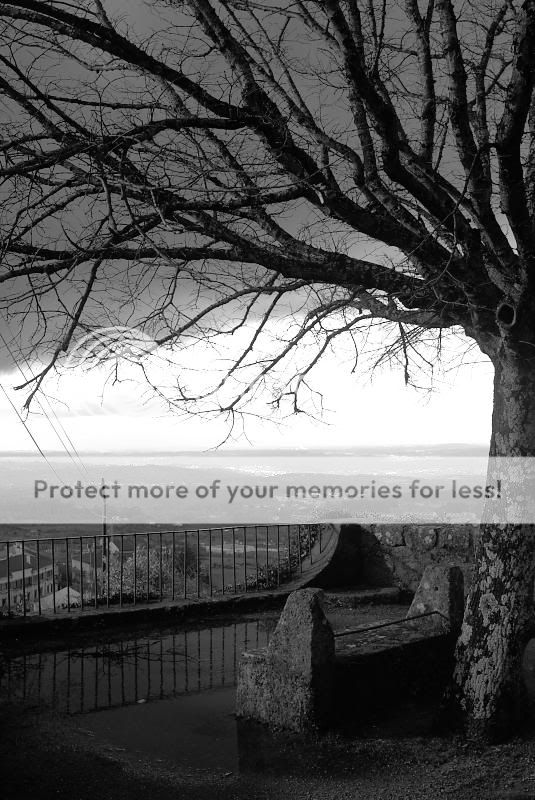Those of you that have been following this blog may have suspected this would happen. I've been considering getting a compact camera for some time. I'm not replacing the Pentax K10D. I love that camera and the Zeiss lenses I've been using with it. I haven't actually felt any need to upgrade it to a newer, more sophisticated, model. But having a small compact with good image quality is something that I've missed since my film Minox 35ML stopped working, more than 10 years ago. A mirrorless camera is lighter and smaller, even though probably less performing. But AF speed, shutter lag or continuous shooting rates are not relevant issues for the kind of photos I take. Deciding which camera I'm going to use each time, the DSLR or the compact, is just a question of context and state of mind.
So after considering the Leica X1 (excellent image quality but high price, perfectible usability, noninterchangeable lens and absence of electronic view finder) and a few other alternatives now in the market of mirrorless but "DSLR quality" cameras (by Panasonic, Sigma, Ricoh and Samsung), I've decided on an
Olympus PEN E-P2 body and a Panasonic Lumix 20mm f/1.7 lens. Just like the one below:
Image taken from Steve Huff's blog. I haven't had the chance to take a photo of my E-P2 yet...
After having tried it for a couple of weeks, I can now try to summarize my current impressions.
Ergonomics
The E-P2 is a good looking camera. I'm a sucker for that retro design. The prominent electronic viewfinder (EVF) almost ruins it though. It is too bulky for such a small body. Besides, if one wants to use a flash, the viewfinder must come off, of course. I'm sure the EP-3 will have a built in viewfinder. But looks and practicality aside, the EVF is a joy to use, even for someone who wears glasses, like me. The image is very clear and has an appropriately large resolution. The fact that it is tiltable up to 90º is useful in some situations, like close-ups, helping avoid bending one's back into awkward positions. The image can be switched to the back LCD display by pressing a button in the base of the viewfinder.
Using the EVF helps holding the camera in a steady position, close to the face and with both arms bent. There are two configurable command dials in the back that can be easily accessed by one's thumb without having to lower the camera. One, the "embedded dial" I use for setting exposure compensation, while the other, the "wheel dial", is for changing aperture. Unfortunately, this one is too sensitive and I often move it unintentionally while carrying the camera in one hand.
There is a Fn button, that is also easily accessible while shooting. I've set it to switch between auto and manual focus. It would be nice if the other buttons (review, delete, menu, etc) were easier to "feel" with the thumb (if they had small pricks, for instance) so I could select each one while looking through the EVF, without having to lower the camera.
Olympus E-P2 + Panasonic 20/1.7 (at 1/800 sec, f/5.6, ISO 200)
One annoying detail is that the Live View histogram is only visible in one viewing mode and cannot be combined with other views. Another annoyance: in auto ISO mode, the value currently selected by the camera is not displayed.
In the end, my overall experience with the E-P2 has made me realize that my Pentax K10D has a truly excellent design and interface. Olympus has tried to build a well thought camera, keeping serious photographers in mind. But some details are not quite right yet. Nonetheless, I have so say that the camera is remarkably comfortable and enjoyable to use.
Focusing
The E-P2 is definitely not a fast action camera. Auto focusing is slow (more than 1/2 second to lock focus). It is usually accurate, though, even in relatively low light. Another problem is that the focus area is rather large, so it is difficult to focus on small subjects. Gladly, the camera can be configured to switch from auto to manual focusing when the lens focusing ring is rotated. This causes the focusing area of the Live View image to be automatically zoomed-in (on the back LCD or on the EVF), to make manual focusing more comfortable and accurate. Even more, in a different operation setting, one can select any area of the image to be magnified, using the cursor function of the wheel dial, and then zoom-in and focus manually. This is excellent for close ups, when tilting the camera for focusing and then reframing might change the focus plane and lead to bad results.
Olympus E-P2 + Panasonic 20/1.7 (at 1/4000 sec, f/2.8, ISO 200)
Speaking of fast action, the E-P2 also has a significant shutter lag. This is a camera for slow photography, definitely.Which is fine by me.
Image quality
No complains up to ISO 800. The sensor response is different from my Pentax K10D in many ways (dynamic range, color, etc). Not better or worse, I mind you, just different. The technical reviews say that the E-P1/E-P2 sensor suffers from low dynamic range. I don't complain so far. Clipped highlights can be recovered in RAW to an impressive extent by lowering exposure.
Here's an image I find quite nice (it's a Chinese coffee pot I've inherited from my grand parents, by the way). The camera was hand held during a 0.5 second exposure, under existing tungsten lighting. Shake reduction works quite well on this camera.
Olympus E-P2 + Panasonic 20/1.7 (at 0.5 sec, f/3.5, ISO 200)
What about higher ISOs? Well well well... At ISO 1600 color noise is evident, demanding some attention in post processing . The bigger problem might be colored patches in the midtone areas, which are more difficult to filter out. But I would say most images are perfectly usable. Take the next example. It was taken in a very badly lit indoor flower exhibition. In camera noise reduction was off and I performed minor noise filtering in Silkypix Pro on the captured RAW file. I would say it is a reasonable result, even though the overall image quality is clearly not the same as one would get at lower ISO values.
Olympus E-P2 + Panasonic 20/1.7 (at 1/15 sec, f/5, ISO 1600)
And ISO 3600? Forget color images, unless you're going to display them in really small sizes. If you go for b&w, however, the results might actually be interesting, as the grayscale noise resembles film grain (OK, I'm not a purist). In the next photo noise reduction was disabled both in the camera and in post-processing. I actually over-sharpened the image a bit to make the "grain" a bit more evident. I think it worked well in this case and intend to explore this approach further.
Olympus E-P2 + Panasonic 20/1.7 (at 1/125 sec, f/2, ISO 3600)
What about ISO 6400? This I have to say is useless. Olympus kept this feature just for marketing, I'm sure. There isn't much I'm able to do with those images. I would love to see what others might accomplish, though.
Concerning the Panasonic 20mm lens, it is sharp and yields very good contrast. Not as sharp as my Zeisses, but I didn't expect it would be. By the way, for those suffering from "
bokeh disease", here's a sample of the lens' rendering of out of focus subjects. Quite good, I would say.
Olympus E-P2 + Panasonic 20/1.7 (at 1/500 sec, f/3.2, ISO 200)
Many say that it is impossible to obtain low enough depth of field on the small sensor of Micro Four Thirds cameras. This, they say, does not allow properly blurred backgrounds, which is supposedly essential for portrait photography. Myself, I don't think this is a significant issue. I prefer to think in the opposite way: with this sensor, one can have at, say, f/2.8 approximately the same DOF as with f/5.6 on a 35 mm film camera. That means you can open the lens two full stops and keep the same DOF! Combine this with a fast lens that is sharp at high apertures and the high ISO limitations in this camera can easily be forgotten.
Olympus E-P2 + Panasonic 20/1.7 (at 1/60sec, f/2.8, ISO 1000)
In conclusion
My E-P2 is not the perfect EVIL (Electronic Viewfinder Interchangeable Lens) compact camera. But the perfect camera (when it is made) might not be as much fun to use as my E-P2...




















